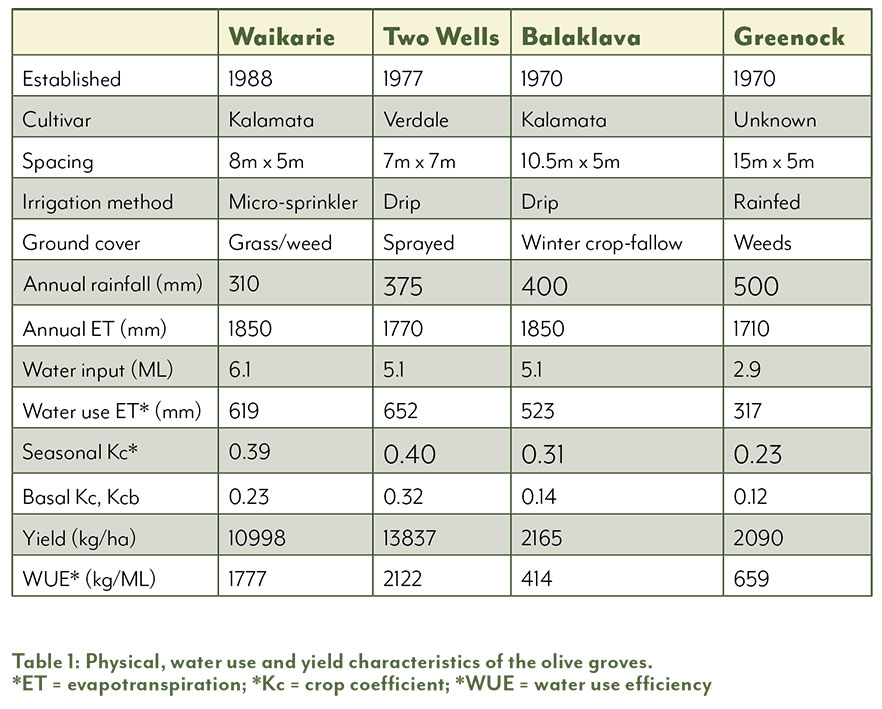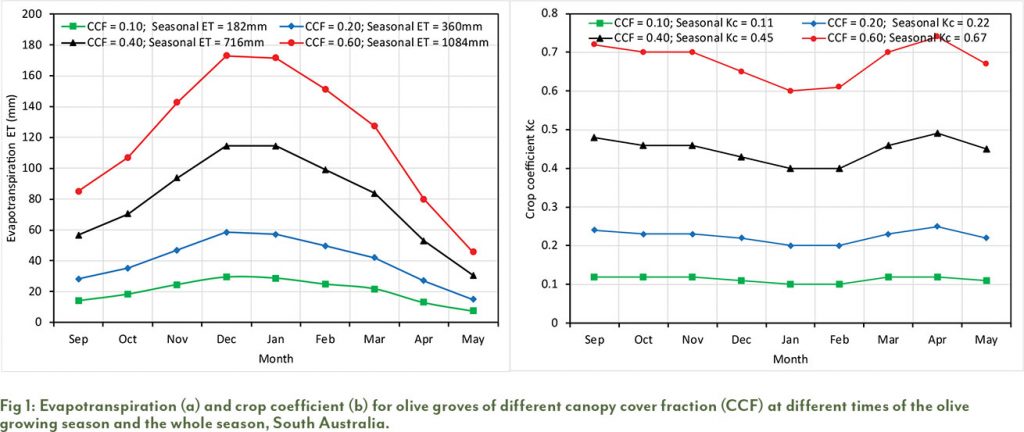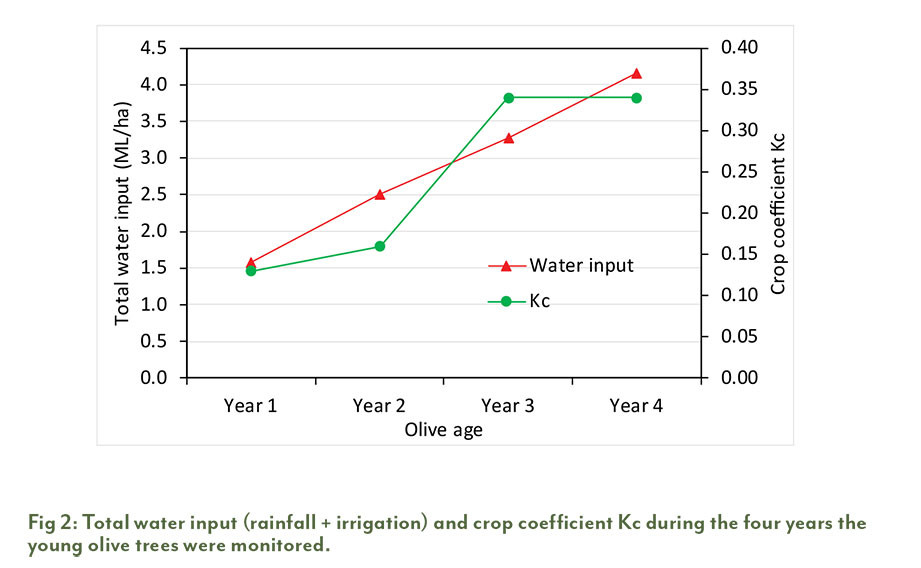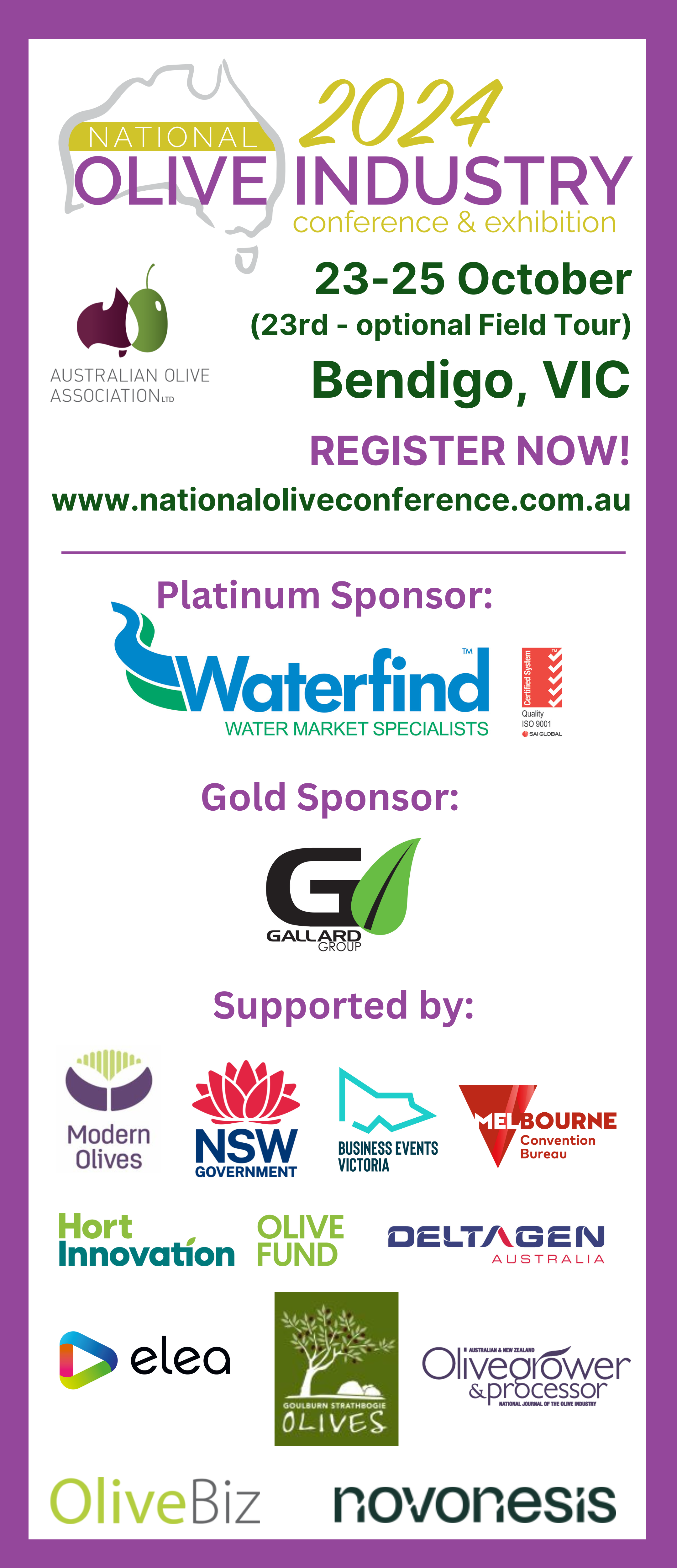Ketema Zeleke, School of Agricultural and Wine Sciences, Charles Sturt University, Wagga Wagga; EH Graham Centre for Agricultural Innovation, Wagga Wagga
This article is part of a series reviewing early olive R&D reports, and covers two publications dealing with the water requirements of olives. Agricultural water management expert Ketema Zeleke identifies the key information available in the resources, particularly around the relationship between water and yield, along with gaps in current knowledge, and provides references to subsequent completed and ongoing research. With summer and the growing season now upon us, there’s plenty to take on board and into your groves.
Review of RIRDC Publication nos. 03/048 (2003) and 05/039 (2005)
Olive water use, relationship between water use and yield and irrigation management guidelines for optimum yield were investigated during two olive growing seasons (Sept-May) of 1999/2000 and 2000/2001 on four mature groves in South Australia (Waikerie, Two Wells, Balaklava, Greenock) in the RIRDC project no. UA-47A “Olive water use and yield – monitoring the relationship” (Nuberg and Yunusa, 2003). The summary of the characteristics of these groves is presented in Table 1.

Each grower of these groves applied the irrigation amount as per their own management decisions. Actual evapotranspiration was determined from soil water balance of rainfall, irrigation and temporal change in soil water content. Soil water content was measured using neutron soil moisture probes. Transpiration was calculated/measured from weather data and sap flow measurement. The seasonal crop coefficient Kc, calculated as the ratio of actual evapotranspiration ETa (determined using soil water balance) to reference evapotranspiration ETo (determined from the weather data), is presented in Table 1. Basal crop coefficient Kb was calculated as a ratio of transpiration T to ETo. Water use efficiency WUE calculated as the weight of olives produced per unit of water use is also shown in Table 1.
Water requirement
Water requirement during a growing season by a typical grove in South Australia was estimated for different crop canopy cover fractions (CCF) (Fig 1a) with the corresponding crop coefficients Kc (Fig 1b). The seasonal water requirement varies between 182 mm (1.82 ML) for groves with small trees and 1084 mm (10.84 ML) for groves with large trees. These correspond to Kc values of 0.10 and 0.70.

Water requirement of young olive trees in the period from planting to the first fruit bearing (from 1.5 to 5.5 years) was determined during four growing seasons of 2000/01 to 2003/04 at Weeroona Park, in South Australia in the RIRDC project no. DEB-2A “From planting to harvest – A study of water requirements of olives, from planting to first commercial harvest” (De Barro, 2005).
The olive trees (cv. Manzanello) were planted in 8m x 5m spacings (250 trees/ha) and irrigated using micro-sprinklers. A research row was selected and isolated for growth and soil moisture monitoring (using C-probe) in a commercial grove. In the research row, irrigation was applied based on the C-probe reading, while in the commercial groves there was no set rule for applying irrigation. The total amount of applied water was determined as the sum of irrigation and effective rainfall.
Irrigation schedule
Irrigation was scheduled according to olive tree water demands as indicated by the C-probe placed at 10, 20, 30, 40 and 70 cm depths. The total water applied (irrigation + rainfall) and the corresponding Kc values during the tree development are shown in Fig 2.

Main messages from the review
- There is a large variation in the amount of water applied to matured olives in the region which shows a lack of consistent irrigation management strategy or guidelines in olives. As a result, there is large variation in Kc, yield and water use efficiency. In the same region, water use varied from 3.17 ML (Kc = 0.23) to 6.52 ML (Kc = 0.40).
- The relatively low Kc values show low water input in these groves, especially during mid-summer.
- There is large year-to-year variation in olive yield, which is mainly due to the alternate bearing characteristics of olives. Management strategies to increase yield stability are required.
- The developed Kc factors (Fig 1 and Fig 2) can be used to calculate the water requirement of olives, an initial guideline of how much water to apply, for mature and young olives respectively. Growers can use these Kc values to estimate the optimum amount of irrigation and evaluate their irrigation practices.
- Young olive trees’ total water requirement varies almost linearly from year 1 (1.5 ML/ha) to year 5 (4.5 ML/ha). There is a tendency to over-irrigate by up to 1 ML/ha in young olive trees which will not result in any extra benefit.
- Water requirement (rainfall + irrigation) of mature olives is about 7ML/ha when there is no cover crop and 9ML/ha where cover crop is maintained throughout the season. The proportion of ET used as transpiration T depends on the water application method: 73% for drip irrigation; 63% for micro-irrigation; and about 50% for a rainfed grove. Therefore, controlling weeds and using drip irrigation increases water use efficiency. However, it should also be noted that cover crops improve soil structure and increase infiltration.
- The average WUE of 1380 kg/ML is within the range (800-1700 kg/ML) of values in the Northern hemisphere (Michelakis, 1990).
- While Kc can be used to determine the amount of irrigation, soil moisture monitoring devices should be used to determine the timing of irrigation. Different management scenarios can be set to trigger irrigation events.
- There is a direct positive relationship between olive yield and the amount of water applied. However, rainfed or water stressed groves might not immediately respond to irrigation and irrigation starts to have impact only when seasonal ET, which is approximately the same as water input, is more than 5 ML/ha. This shows the need for irrigating young olives with full water requirements so that it performs well right from the first fruit bearing. This also has implications when converting rainfed olives to an irrigated system.
The conclusions in light of recent research
Kc for mature olive trees
Crop water use ETc calculation is a two-step process from the relation ETc = ETo x Kc: first ETo is calculated from weather data, next Kc is determined for the given crop and its growth stage. Since weather naturally varies from region to region, there is no point in comparing values for different regions. However, it is worth evaluating/comparing Kc values since the effect of crop is expressed using crop coefficient Kc, which can be similar for different regions.
For a typical CCF of 0.40, the proposed Kc values (0.40 – 0.50) were relatively low compared to the 0.55 – 0.78 values proposed by many olive researchers (e.g. Goldhamer et al., 1993; Zeleke, 2014; Grattan et al., 2006; Villalobos et al., 2000; Paco et al., 2019; Paco et al., 2014; Allen and Pereira, 2009).
Kc for young olive trees
The Kc value was found to be varying from 0.15 – 0.34 for the young olive trees of 1.5 – 5.5 years old. In the RIRDC Publication no. 05/039 (De Barro, 2005), CCF was not measured, although crop coefficient mainly depends on canopy cover.
Most of the crop factor studies in literature separate Kc into basal crop coefficient Kcb and the evaporation component Ke. For young olive trees, Puppo et al. (2019) developed a linear regression between basal crop coefficient (Kcb) and canopy light interception, from which they determined mid-season Kcb of 0.35. For young irrigated groves of different ages, Testi et al. (2004) reported Kc of 0.19 (for 2 years with CCF = 0.05), Kc of 0.25 (for 3 years with CCF = 0.15), and Kc of 0.35 (for 3 years with CCF = 0.25). Similarly, Puppo et al. (2019) determined Kc using a drainage lysimeter and reported that water consumption and Kcmid (Kc summer) increases with the age of trees and canopy cover as Kcmid = 0.031 (age) + 0.086. This shows that Kcmid = 0.14, 0.15, 0.21, 0.25, 0.30 for 1 yr, 2 yr, 3 yr, 4yr, 5yr and 6yr trees respectively.
Water use
In south-eastern NSW, using soil water balance approach, Zeleke (2014) estimated that ET of olives is 7.23 ML (723 mm) and 6.73 ML (673 mm) in “on” and “off” years, respectively. This (7.23 ML) agrees with the matured olive trees water requirement of 7 ML reported in the RIRDC report no. 03/048 (Nuberg and Yunusa, 2003). Zeleke (2014) reported that soil water extraction is limited mainly to the top 60 cm, as observed by Nuberg and Yunusa (2003), and root distribution is concentrated mainly in the direction of olive row or drip lateral. This has important implication in the application of inputs such as fertiliser. The results of several studies have concluded that deficit irrigation strategies (sustained and/or regulated) are essential for sustainable olive growing in regions with limited water resources (Goncalves et al., 2020; Iniesta et al., 2009; del Campo et al., 2013, Zeleke and Ayton, 2014, Santos 2018). This means irrigation strategies require precise knowledge of the crop/tree response to water deficits during different phenological/growth stages. However these reports, Nuberg and Yunusa (2003) and De Barro (2005), assume full irrigation throughout the season.
Summary on water requirement of olives
Canopy cover fraction (CCF) is the main variable that determines crop’s light interception and most of the variations in crop water consumption.
Ground cover (crop or weed) in the grove and irrigation method affects consumptive water use of olives. For example, Allen and Pereira (2009) have shown that when there is no ground cover Kc is 0.50, while it is 0.70 when there is active ground cover.
Deficit irrigation
A large volume of studies elsewhere and several studies in Australia show that full irrigation of olives is not necessarily required. Deficit irrigation, especially regulated deficit irrigation during the pit-hardening stage, enhances water use efficiency, water productivity, oil content, and increases oil quality. Deficit irrigation (sustained and/or regulated) reduces water use, increases radiation use efficiency and water use efficiency maintaining a good balance between crop load and water productivity. In regions with limited water resources, deficit irrigation strategies can be used for sustainable olive production (Goncalves et al., 2020).
Irrigation from establishment
Groves that had been under regimes of water-stress may not respond immediately to improved water-supply regimes as low input management can condition olive trees to produce low yield. As a result, it is important to have an optimum irrigation schedule right from the start when new groves are established. This should prime the trees for producing high and consistent yields. However, there is a tendency to apply too much water to young olives. Too much water use at these growth stages can affect the growth due to water logging, leach nutrients and waste precious water. Too little irrigation can affect the growth and the trees might not be able to respond to irrigation once fruiting begins.
Subsequent completed research
Completed subsequent research on water use and water use efficiency of olives in Australia and elsewhere is given the References section.
Research currently underway
Satellite remote sensing has been found to be successfully used to estimate spatial and temporal variability of evapotranspiration of olives with strong correlation with ground truth measurements (Bchir et al., 2019). In this line, the University of New England (UNE) and NSW Department of Primary Industries (DPI) are undertaking a remote sensing project to assess and map dry matter production and yield of olive and other tree crops (ref below).
Future research needs/gaps to be undertaken
Although there are some useful research reports on olive water requirement, yield, and water use efficiency in Australia, there are no controlled/replicated experiments on olive water use and water use efficiency for different environments, olive growth stages, and irrigation management scenarios. Since these reports were evaluating just the farmers’ practices, there was no replication or rigorous statistical analysis in the trials.
Replicated trials
As a result, the differences can be just due to chance. So replicated trials at a single or multiple homogenous sites with different irrigation amounts and its effect on olive yield, water use efficiency, oil yield and quality is recommended.
Optimal irrigation management
This will help to identify optimal management scenarios: irrigation management in “on” and “off” seasons and water management scenarios to minimise yield fluctuation needs to be determined.
As water is becoming a high value resource, measuring optimum olive water requirement for maximum yield and gross margin which takes into account olive yield and input costs, including cost of water, is becoming important.
Some studies have indicated that withholding or reducing irrigation during the pit-hardening period had only minor/no effect on fruit size, timing of maturity, oil content or quality while saving irrigation water (Rosecrance et al., 2015; Zeleke and Ayton, 2014; Zeleke et al., 2012). However, the effect of full irrigation, sustained and/or regulated deficit irrigation on olive yield, water use efficiency, and gross margin is yet to be determined in the region.
Moisture monitoring guidelines
In order to develop guidelines for the use of soil moisture monitoring devices for olive irrigation scheduling (when to apply and how much), growth and yield response of young and mature olives for different soil moisture stress levels, as recorded by these devices, needs to be developed using replicated studies.
Evapotranspiration
Olive evapotranspiration needs to be determined following the standard two-step process: reference evapotranspiration from weather data and measurement of potential evapotranspiration from well-watered and well-managed olive groves. Then develop a relationship between Kc, ETc, and canopy cover using olives of different age at different times of the year.
The separation of Kc into Kcb and Ke will help to relate Kcb to percent radiation interception by the tree canopy which is related to evapotranspiration. Basal crop coefficient Kcb is a function of canopy cover and canopy light interception. Romero-Trigueros et al. (2019), described ETc = Kr x Kc x ETo where Kr is reduction coefficient, calculated from the tree canopy diameter or percentage of soil shaded by the canopy.
More information
You can find out more about the multi-industry remote sensing project, which also includes monitoring of water requirements for olives, via presentation recordings on the OliveBiz website www.olivebiz.com.au. Access Remote Sensing – The Sky Is The Limit from the 2019 AOA National Olive Conference Presentations, Day 1 listing in Events; and the Update on the irrigation trials/oil accumulation results in the Webinars listing in Projects.
References
Allen, R.G., Pereira, L.S. (2009). Estimating crop coefficients from fraction of ground cover
and height. Irrig. Sci. 28:17–34.
Bchir, A., Mulla, D.J., Dhiab, A.B., Meriem, F.B., Bousetta, W., Braham, M. (2019). Assessing spatial and temporal variability in evapotranspiration for olive orchards in Tunisia using satellite remote sensing. Precission Agriculture’ 19:431-436.
De Baro, J. (2005). From planting to harvest – A study of water requirements of olives, from planting to first commercial harvest. RIRDC Publication no. 05/039.
del Campo, M.G., Garcia, J.M. (2013). Summer deficit-irrigation strategies in a hedgerow olive cv. Arbequina orchard: effect on oil quality. J Agr Food Chem 61:8899–8905.
Goldhammer, D.A., Dunai, J., Fergusson, L. (1993). Water use of Manzanillo olives and responses to sustained deficit irrigation. Acta Hort. 335: 365–371.
Goncalves, A., Silva, E., Brito, C., Martins, S., Pinto, L., Dinis, L., Luzio, A., Martins-Gomes, C., Fernandes-Silva, A., Riberio, C., Rodrigues, M.A., Moutinho-Pereira, J., Nunes, F.M., Correia, C.M. (2020). Olive tree physiology and chemical composition of fruits aremodulated by different deficit irrigation strategies. J Sci Food Agric. 100: 682–694.
Grattan, S.R., Berenquer, M.J., Connell, J.H., Polito, V.S., Vossen, P.M. (2006). Olive oil production as influenced by different quantities of applied water. Agr. Water Manage 85:133–140.
Iniesta, F., Testi, L., Orgaz, F., Villalobos, F.J. (2009). The effects of regulated and continuous deficit irrigation on the water use, growth and yield of olive trees. Eur J Agron 30:258–265.
Michelakis, N. (1990). Yield response of table and oil olive varieties to different water use levels under drip irrigation. Acta Hort. 286: 271–274.
Nuberg, I., Yunusa, I. (2003). Olive water use and yield – monitoring the relationship. RIRDC Publication no. 03/048.
Paço, T.A., Paredes, P., Pereira, L.S., Silvestre, J., Santos, F.L. (2019). Crop coefficients and transpiration of a super intensive Arbequina olive orchard using the dual Kc approach and the Kcb computation with the fraction of ground cover and height. Water, 11:383.
Paço, T.A., Pocas, I., Cunha, M., Silvestre, J.C., Santos, F.L., Paredes, P., Pereira, L.S. (2014). Evapotranspiration and crop coefficients for a super intensive olive orchard. An application of SIMDualKc and METRIC models using ground and satellite observations. J. Hydrol. 519:2067–2080.
Puppo, L., Garcia, C., Bautista, E., Hunsaker, D.J., Beretta, J.G. (2019). Seasonal basal crop coefficient pattern of young non-bearing olive trees grown in drainage lysimeters in a temperate sub-humid climate. Agric. Water Manage. 226:105732.
Romero-Trigueros, C., Vivaldi, G.A., Nicolas, E.N., Paduano, A., Salcedo, F.P., Camposeo, S. (2019).
Ripening indices, olive yield and oil quality in response to irrigation with saline reclaimed water and deficit strategies. Frontiers in Plant Science, 10:1243.
Rosecrance, R. C., Krueger, W. H., Milliron, L., Bloese, J., Garcia, C., and Mori, B. (2015). Moderate regulated deficit irrigation can increase olive oil yields and decrease tree growth in super high density ‘Arbequina’ olive orchards. Sci. Hortic. 190:75–82.
Santos, F.L. Olive water use, crop coefficient, yield, and water productivity under two deficit irrigation strategies. Agronomy 2018, 8:89.
Testi, L., Villalobos, F.J., Orgaz, F. (2004). Evapotranspiration of a young irrigated olive orchard in southern Spain. Agric. For. Meteorol. 121:1–18.
Villalobos, F.J., Orgaz, F., Testi, L., Fereres, E. (2000). Measurement and modelling of
evapotranspiration of olive (Olea europaea L.) orchards. Eur. J. Agron. 13:155–163.
Zeleke, K.T. (2014) Water use and root zone water dynamics of drip-irrigated olive (Olea europaea L.) under different soil water regimes. N. Z. J. Crop Hort. Sci., 42 (3):217-232
Zeleke, K.T., Ayton, J. (2014). Fruit and oil quality of olive (Olea europaea L.) under different irrigation regimes and harvest times in south eastern Australia. J. Food Agric. Environ. 12:458–464.
Zeleke, K.T., Mailer, R., Eberbach, P., and Wünsche, J. (2012). Oil content and fruit quality of nine olive (Olea europaea L.) varieties affected by irrigation and harvest times. New Zeal. J. Crop Hortic. Sci. 40:241–252.



